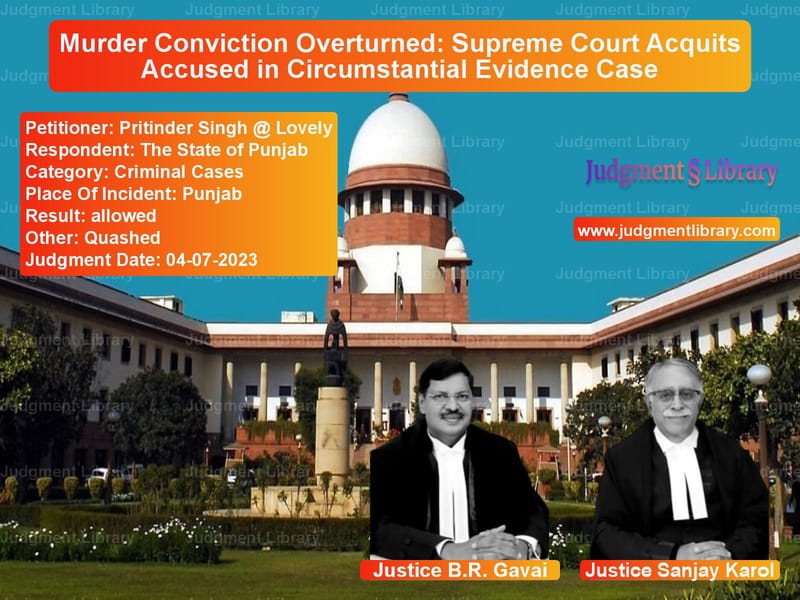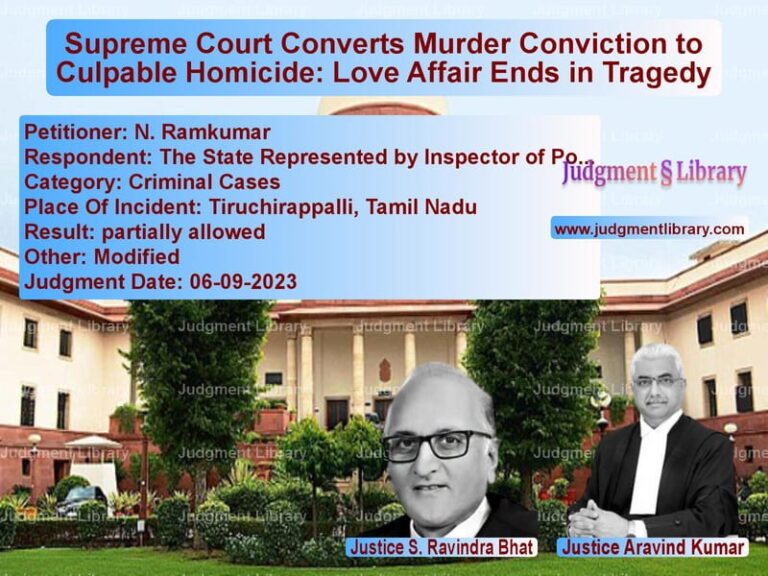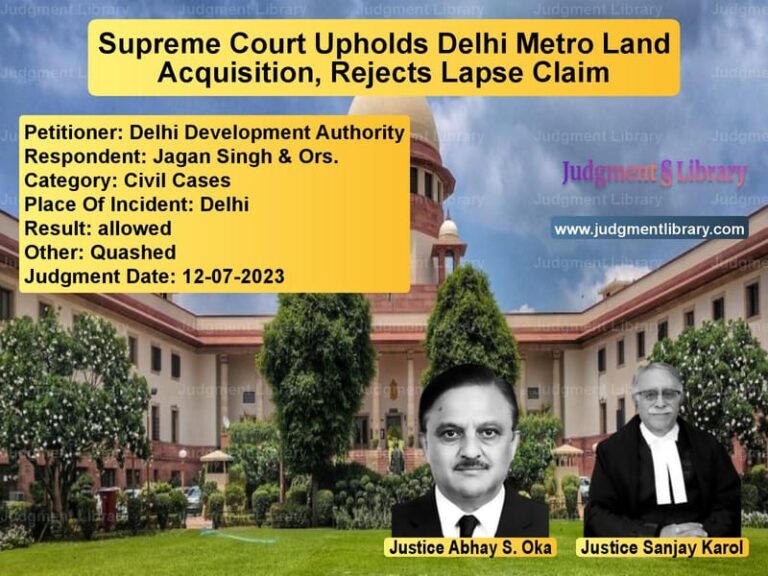Murder Conviction Overturned: Supreme Court Acquits Accused in Circumstantial Evidence Case
The case of Pritinder Singh @ Lovely v. The State of Punjab is a significant ruling by the Supreme Court regarding convictions based solely on circumstantial evidence. The Court, on July 5, 2023, overturned the conviction of the accused due to inconsistencies in evidence, unreliable witness testimony, and a lack of forensic corroboration. The judgment highlights the fundamental principle that suspicion, however strong, cannot replace proof beyond a reasonable doubt in criminal trials.
Background of the Case
The case pertains to the murder of Ravinder Singh, which took place on September 3, 1998. The prosecution alleged that the accused, Pritinder Singh @ Lovely and Manjit Kaur, murdered Ravinder Singh due to ongoing disputes. The prosecution relied on circumstantial evidence, including the ‘last seen’ theory and an alleged extra-judicial confession.
The trial court found the accused guilty under Section 302 read with Section 34 of the Indian Penal Code (IPC) and sentenced them to life imprisonment. The High Court of Punjab and Haryana upheld the conviction. The accused then approached the Supreme Court.
Key Legal Issues
- Whether the prosecution established an unbroken chain of circumstantial evidence linking the accused to the crime.
- Whether the extra-judicial confession was voluntary and reliable.
- Whether the forensic evidence corroborated the prosecution’s case.
Prosecution’s Case
The prosecution presented the following key arguments:
- The deceased, Ravinder Singh, was last seen alive with the accused.
- The accused allegedly confessed to the murder before an ex-Sarpanch, Mal Singh.
- The weapon used in the crime, a 12-bore double-barrel gun, was allegedly recovered from the accused’s possession.
- The forensic report linked the recovered cartridges to the firearm.
Defense’s Arguments
The defense challenged the conviction on several grounds:
- The prosecution’s case was based on weak circumstantial evidence without direct proof.
- The alleged extra-judicial confession was unreliable and lacked corroboration.
- The ballistic expert was not examined, raising doubts about the forensic evidence.
- The ‘last seen’ theory was insufficient to establish guilt beyond a reasonable doubt.
- The prosecution failed to prove motive convincingly.
Supreme Court’s Observations
The Supreme Court, while overturning the conviction, relied on well-established legal principles regarding circumstantial evidence. The Court referred to its landmark decision in Sharad Birdhichand Sarda v. State of Maharashtra, which laid down the five essential conditions for convicting an accused based on circumstantial evidence:
(1) The circumstances from which the conclusion of guilt is to be drawn should be fully established.
(2) The facts must be consistent only with the hypothesis of guilt and not with any other hypothesis.
(3) The circumstances must be conclusive in nature.
(4) There should be no alternative explanation other than the accused’s guilt.
(5) The chain of evidence must be so complete that no reasonable ground exists for the accused’s innocence.
The Court found that these conditions were not met in this case.
On the Extra-Judicial Confession
The Supreme Court ruled that extra-judicial confessions should be treated with caution. It noted:
“An extra-judicial confession, if voluntary and true and made in a fit state of mind, can be relied upon by the court. The confession will have to be proved like any other fact. The value of the evidence as to confession, like any other evidence, depends upon the veracity of the witness to whom it has been made.”
In this case, the alleged confession was made to an ex-Sarpanch (Mal Singh) 100 km away from the crime scene. The Court found it highly improbable that the accused would travel such a distance to confess. Moreover, the witness did not immediately report the confession, reducing its credibility.
On the ‘Last Seen’ Theory
The prosecution relied on the testimony of witnesses who claimed that the deceased was last seen with the accused. However, the Court noted that:
“Merely being last seen together cannot, by itself, lead to the inference of guilt. The prosecution must establish a proximate link between the last sighting and the crime.”
The Court observed that the alleged time gap between the last sighting and the recovery of the dead body was too long to infer direct involvement.
On Forensic Evidence
The Court found significant lapses in the forensic investigation:
- The prosecution failed to examine the ballistic expert to establish whether the recovered cartridges matched the alleged weapon.
- The prosecution did not conclusively establish the ownership of the firearm.
- The failure to link the weapon to the crime created serious doubts about the prosecution’s case.
Conclusion and Final Judgment
The Supreme Court held that the prosecution failed to prove guilt beyond a reasonable doubt. It emphasized:
“However strong a suspicion may be, it cannot take the place of proof beyond reasonable doubt.”
The Court ruled that the accused were entitled to the benefit of the doubt and acquitted them.
Implications of the Judgment
This ruling has significant implications for criminal trials based on circumstantial evidence:
- Strengthening the Standard of Proof: The judgment reinforces the principle that conviction must be based on irrefutable evidence.
- Precautions in Relying on Extra-Judicial Confessions: Courts must be cautious while accepting confessions made outside of judicial proceedings.
- Need for Forensic Corroboration: Proper scientific examination and expert testimony are crucial in cases involving forensic evidence.
Conclusion
The Supreme Court’s decision in Pritinder Singh @ Lovely v. The State of Punjab is a reaffirmation of the fundamental principles of criminal law. It underscores the necessity of clear, cogent, and convincing evidence before convicting an accused. The ruling serves as a critical precedent for ensuring that circumstantial evidence is scrutinized thoroughly before a conviction is secured.
Petitioner Name: Pritinder Singh @ Lovely.Respondent Name: The State of Punjab.Judgment By: Justice B.R. Gavai, Justice Sanjay Karol.Place Of Incident: Punjab.Judgment Date: 04-07-2023.
Don’t miss out on the full details! Download the complete judgment in PDF format below and gain valuable insights instantly!
Download Judgment: pritinder-singh-@-lo-vs-the-state-of-punjab-supreme-court-of-india-judgment-dated-04-07-2023.pdf
Directly Download Judgment: Directly download this Judgment
See all petitions in Murder Cases
See all petitions in Judgment by B R Gavai
See all petitions in Judgment by Sanjay Karol
See all petitions in allowed
See all petitions in Quashed
See all petitions in supreme court of India judgments July 2023
See all petitions in 2023 judgments
See all posts in Criminal Cases Category
See all allowed petitions in Criminal Cases Category
See all Dismissed petitions in Criminal Cases Category
See all partially allowed petitions in Criminal Cases Category







